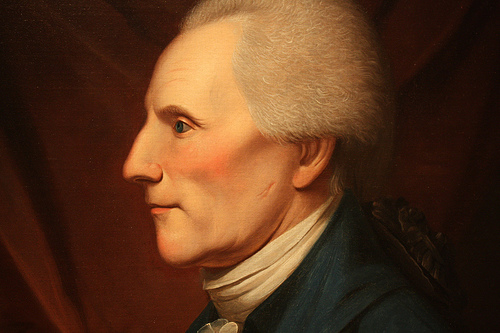Many historians of the American Revolution have noted the importance of the leadership of the revolutionary movement exercised by the Whigs of Massachusetts and those of Virginia. They provided leadership during the ten years of agitation against British measures that began with the resistance to the Stamp Act of 1765. After the convening of the Continental Congress in September 1774, a vigorous alliance between New England and the Southern colonies provided the most active Whig leadership within the Continental Congress. But how, in the wake of the Townshend Act but before the first meeting of the Continental Congress, that is, in the crucial 'quiet time' of 1771-1773, did an active communications link become forged between the political leadership of Boston and Virginia? The chart at the right traces the steps by which detailed news of Boston measures (forming a committee of correspondence, publishing the Votes and Proceedings, provoking the Governor in a debate, etc.) spread to Viriginia, encouraging that colony to develop important initiatives of its own (most importantly, Virginia's appeal to the Speakers of the 12 other colonial assemblies to form a committee of correspondence so that they could align their measures of political resistance.) Within this context the leader of the Whigs in each province, Richard Henry Lee and Samuel Adams, began their private correspondence on the public political crisis. It offers a leading instance of the trusted communication so essential to revolution. |
From Boston to Virginia → |
← From Virginia to Boston |
9 November 1772: Boston Gazette report on town meeting’s 2 November appointment of Boston committee → |
3 December Reprinted by the Virginia Gazette
|
23 November: Boston Gazette report of 20 November town meeting where Votes is accepted: excerpt: “A Free Communications…” → |
12 December Reprinted by the Virginia Gazette
|
6 January, 1773: Speech of the Governor opening the General Court & Thomas Cushing sends Votes and Proceedings to Richard Henry Lee →
|
← 4 February 1773: Richard Henry Lee letter to Samuel Adams requesting information about the Gaspe Commission
← 13 February: RH Lee to Thomas Cushing
confirms receipt of the Votes and Proceedings |
12 January: Boston Gazette reprints the 6 January speech of Governor opening the General Court →
|
18 February: Virginia Gazette reprints Governor’s speech; part of Votes; laudatory commentary upon the response of the towns |
22 January Boston Gazette reprints response of the Council & 1 February, the response of the House → |
4 March: Virginia Gazette reprints replies of Council and House
|
|
← 12 March: Virginia House of Burgesses appoints a committee of correspondence to correspond with the speakers of the assemblies of the other colonies
13 March: 1st meeting Virginia Committee of Correspondence, Peyton Randolph Chair;
← 19 March: the committee sends resolves to the Speakers of the assemblies of all 12 other colonies |
9 April: since the General Court is prorogued, Virginia committee of correspondence’s letter is rerouted to the Boston committee, which holds a special meeting to read it; it orders the letter and resolves printed as a broadside for distribution to the towns and districts of Mass and requests their Chairman, Samuel Adams, to write Richard Henry Lee
10 April: Samuel Adams writes a private letter to Lee, responding to Lee’s letter of 4 Feb 1773 →
12 April: Virginia letter and resolves are reprinted in the Boston Gazette
27 May 1773: the Massachusetts House institutes its own committee of correspondence which transmits the resolves of the House to the Virginia committee |
 |
|

![Protocols of Liberty: Communication, Innovation, and teh American Revolution [Book Banner from Title Page Image]](Images/William_Warner/Protocols_of_Liberty_Illustrations/Protocols of Liberty - Title Banner.png)


![Protocols of Liberty: Communication, Innovation, and teh American Revolution [Book Banner from Title Page Image]](Images/William_Warner/Protocols_of_Liberty_Illustrations/Protocols of Liberty - Title Banner.png)
